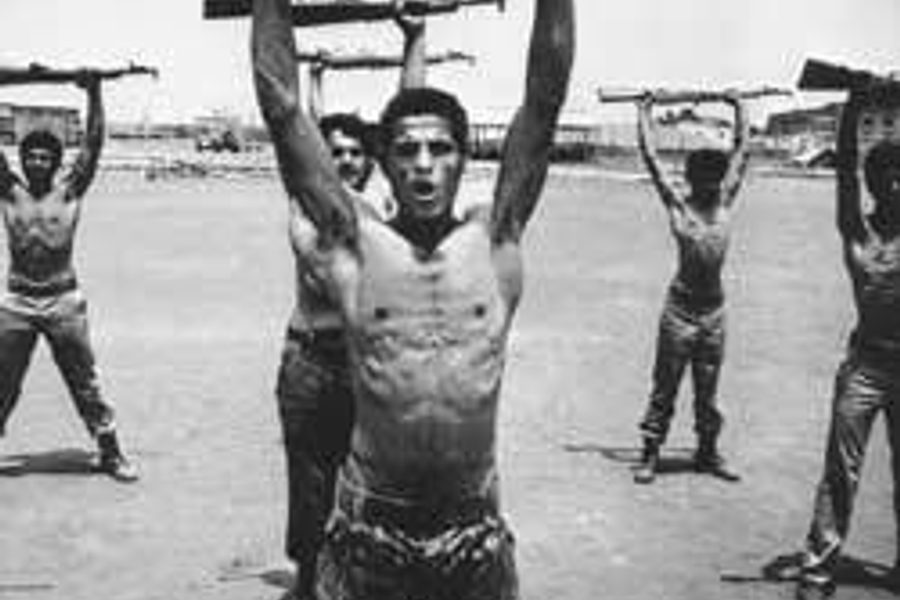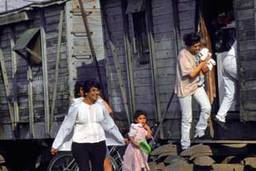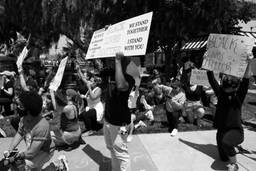
Fortunately, this little book is poorly written. If it were more coherent, it might be dangerous. Paul Berman is associated with Dissent, but he has little of that distinguished independent left journal’s clarity. His work is stylistically clumsy, marred by pretension and intellectual name dropping, disfigured by errors of fact, and further embarrassed by the grandiose use of the first person.
Which is unfortunate, because Berman does have an argument. He contends that the Islamic world is characterized by “mass political movements” that are “drunk on the idea of slaughter.” This “Muslim totalitarianism” owes some of its intellectual content to the fascist and Communist European movements of the 20th century. He also suggests that a comparison with Cambodia’s genocidal Khmer Rouge is no exaggeration.
Berman’s target is Western liberals. These naïve souls have an “excessive faith in rationality,” and they wrongly blame the West, its policies and its global culture, for Islamic rage. Berman insists that we must recognize that we are confronting “apocalyptic and death-obsessed mass movements,” that we must fight a full-scale “Terror War” against the irrational contemporary equivalents of Hitler and Stalin. He ends with surprising sympathy for George W. Bush, and an implicit endorsement of the U.S. invasion of Iraq.
Berman’s choppy and inept writing jumps back and forth with such confusion between the radical Islamists typified by Osama bin Laden and Baath Socialism represented by Saddam Hussein that the reader might not recognize the two have been deadly enemies for decades. But he is right to point out that neither is incomprehensibly medieval or exotic. Baathist ancestry is clear; the movement emerged in the 1940s, influenced by European fascism, and its more extreme adherents advocate a form of Arab chauvinism that can only be called racist. But even radical Islamism has modern elements. Malise Ruthven’s recent A Fury for God provides a much clearer intellectual history of the movement, whose leading members are almost never traditional Muslim scholars, but lawyers and engineers, comfortably at home with modern technology.
Berman is also right to raise questions about the West blaming itself. Just after September 11, some Europeans and some Americans rushed immediately to insist the United States had provoked the attacks. This “blowback” analysis does have some merit; the United States and its ally, Saudi Arabia, did originally promote bin Laden and his jihadists against the Soviets in Afghanistan, and Donald Rumsfeld’s 1983 visit to Saddam Hussein representing the Reagan administration did exemplify the considerable Western financial and military support for the Baathist regime.
But blowback is exaggerated. People in Egypt or Pakistan or Morocco take political action because of what they experience in their own world. A young Egyptian joins the murderous Islamic Group not mainly because he dislikes U.S. foreign policy, but because he struggled for years only to discover his hard-won college diploma is nearly worthless in a saturated job market, he therefore has to postpone marriage indefinitely, he has no chance to vote out the corrupt ruling elite that governs him, and if he protests he may be horribly tortured.
Indeed, torture does seem to be a significant factor pushing some people over the edge, such as Ayman Al-Zawahiri, the No. 2 man in al-Qaeda. Such a young man, enraged beyond reason, may fit Berman’s description. But by far the biggest failure in Terror and Liberalism is to recognize just how rare this violent fanaticism is. He insists repeatedly that “in large parts of the world, a radical movement of radical Islamists had arisen, devoted to mad hatreds,” and that to regard the struggle as a mere police action is dangerously naïve. But he is completely wrong. Twenty months after 9/11, al-Qaeda turns out to be much smaller than originally feared. The attacks on New York and Washington were devastating, but they required only a few hundred thousand dollars and a few dozen conspirators; modern technology magnified their impact horribly. John Ashcroft has not uncovered vast webs of conspiracy inside the United States, despite his disrespect for civil liberties.
————–
In the Middle East, the great mass of people have rejected violent Islamism and the attacks on civilians. Berman says he has “greatly relied” on Gilles Kepel, the French authority on Islamism (who is one of his pitiful handful of sources). But he utterly disregards the conclusion of Kepel’s masterwork, Jihad: The Trail of Political Islam. Kepel sums up decades of firsthand experience: “In spite of what many commentators contended in its immediate aftermath, the attack on the United States was a desperate symbol of the isolation, fragmentation, and decline of the Islamist movement, not a sign of its strength and irrepressible might.”
What is remarkable about the Middle East is the rejection of indiscriminate violence. A key event took place on November 17, 1997, in Egypt, whose 71 million people form the largest Arab state. A small band, apparently attached to the Islamic Group, attacked tourists in the courtyard of the Temple of Hatshepsut at Luxor, killing 62 people. Widespread revulsion among the Egyptian public forced the Group to declare a cease-fire, and tourism has long since revived.
Berman’s book draws parallels with Europe in the last century. Now how’s this for an analogy: What happened in Egypt is as if Germans, even on the right, were so repelled by Nazi violence in the ’20s and early ’30s that Hitler and his small band of Nazis had to leave the country, hide out in remote mountains somewhere, and launch terrorist attacks from there. Today, the violent Islamists do remain a serious threat, but we are not engaged in a “terror war” against an entire people.
Meanwhile, moderate Islamism is still a major force. Political observers in Egypt say that the outlawed Muslim Brotherhood, the oldest Islamic organization in the region, would be a significant force in genuine free elections, possibly the largest single party. But the Brotherhood pledged itself to nonviolence back in the ’60s, and it has tenaciously stuck to that commitment, even though the Mubarak regime, America’s ally, has regularly sentenced its leaders to years in prison, closed its offices, and prohibited its members from meeting. (There was another wave of arrests, including an 80-year-old prayer leader named Mahmoud Shukri, in April.)
Instead of slandering Arabs indiscriminately as fanatics, Berman might have taken a closer look at this remarkable example of courage and restraint. The fall of Saddam Hussein (which took place after Berman finished his book) further undermines his argument. The Iraqi regime was clearly totalitarian, but it did not enjoy the widespread support of masses of people who were “drunk on slaughter?” willing to fight to the bitter end.
————–
There is one important exception to the mass repudiation of violence in the Arab world: Israel and Palestine. Suicide bombings against Israeli civilians, although immoral and a violation of international law, do have popular support, in Palestine and elsewhere. But even here, Berman’s analysis is flawed. He assumes Israel is a rational and calm democracy, which is reluctantly and with restraint confronting Palestinians driven insane with hatred. But he totally ignores the violent element in Israeli life, a surprise in a book about extremism. He has nothing much to say about the right-wing religious settlers who are the most aggressive of the 200,000 Israeli colonists in the Occupied Territories that are the biggest obstacle to peace.
A little history would be useful: There were no suicide bombings in Israel during the first Palestinian intifada, or uprising, which lasted from 1987 to 1992. Then, in February 1994, a Brooklyn-born Israeli, Dr. Baruch Goldstein, entered a mosque in Hebron, a city in Occupied Palestine, armed with an assault rifle, and slaughtered 29 Palestinians at prayer until the crowd overpowered and killed him. Goldstein had carried out what was clearly in some sense a suicide attack. Palestinian retaliatory suicide bombings started the next month. A year and a half later, another Israeli fanatic, Yigal Amir, murdered Israel’s prime minister, Yitzhak Rabin, just after Rabin had spoken at a peace rally, and other Israeli extremists celebrated Rabin’s death. His widow, Leah, said she felt more genuine sympathy from Yasir Arafat than she did from certain leading right-wing politicians in her own country. None of this seems to have stimulated Berman’s inquiry into the intellectual roots of violent political behavior.
Instead, he insists that “in Palestine, a mass pathology had broken out,” and he excoriates Western liberals who refuse to recognize it. So far, Palestinian suicide bombings, however ugly and illegal, do seem to be still a political tactic that would end once a genuine Palestinian state was established. But if the occupation continues—with the killings, arrests, torture, and illegal demolition of homes—Palestinian violence could spin out of control. But its primary cause would not be the influence of ideas, whether from European fascists or Islamic extremists, but the brutal everyday reality of Israeli colonial occupation.
Which is unfortunate, because Berman does have an argument. He contends that the Islamic world is characterized by “mass political movements” that are “drunk on the idea of slaughter.” This “Muslim totalitarianism” owes some of its intellectual content to the fascist and Communist European movements of the 20th century. He also suggests that a comparison with Cambodia’s genocidal Khmer Rouge is no exaggeration.
Berman’s target is Western liberals. These naïve souls have an “excessive faith in rationality,” and they wrongly blame the West, its policies and its global culture, for Islamic rage. Berman insists that we must recognize that we are confronting “apocalyptic and death-obsessed mass movements,” that we must fight a full-scale “Terror War” against the irrational contemporary equivalents of Hitler and Stalin. He ends with surprising sympathy for George W. Bush, and an implicit endorsement of the U.S. invasion of Iraq.
Berman’s choppy and inept writing jumps back and forth with such confusion between the radical Islamists typified by Osama bin Laden and Baath Socialism represented by Saddam Hussein that the reader might not recognize the two have been deadly enemies for decades. But he is right to point out that neither is incomprehensibly medieval or exotic. Baathist ancestry is clear; the movement emerged in the 1940s, influenced by European fascism, and its more extreme adherents advocate a form of Arab chauvinism that can only be called racist. But even radical Islamism has modern elements. Malise Ruthven’s recent A Fury for God provides a much clearer intellectual history of the movement, whose leading members are almost never traditional Muslim scholars, but lawyers and engineers, comfortably at home with modern technology.
Berman is also right to raise questions about the West blaming itself. Just after September 11, some Europeans and some Americans rushed immediately to insist the United States had provoked the attacks. This “blowback” analysis does have some merit; the United States and its ally, Saudi Arabia, did originally promote bin Laden and his jihadists against the Soviets in Afghanistan, and Donald Rumsfeld’s 1983 visit to Saddam Hussein representing the Reagan administration did exemplify the considerable Western financial and military support for the Baathist regime.
But blowback is exaggerated. People in Egypt or Pakistan or Morocco take political action because of what they experience in their own world. A young Egyptian joins the murderous Islamic Group not mainly because he dislikes U.S. foreign policy, but because he struggled for years only to discover his hard-won college diploma is nearly worthless in a saturated job market, he therefore has to postpone marriage indefinitely, he has no chance to vote out the corrupt ruling elite that governs him, and if he protests he may be horribly tortured.
Indeed, torture does seem to be a significant factor pushing some people over the edge, such as Ayman Al-Zawahiri, the No. 2 man in al-Qaeda. Such a young man, enraged beyond reason, may fit Berman’s description. But by far the biggest failure in Terror and Liberalism is to recognize just how rare this violent fanaticism is. He insists repeatedly that “in large parts of the world, a radical movement of radical Islamists had arisen, devoted to mad hatreds,” and that to regard the struggle as a mere police action is dangerously naïve. But he is completely wrong. Twenty months after 9/11, al-Qaeda turns out to be much smaller than originally feared. The attacks on New York and Washington were devastating, but they required only a few hundred thousand dollars and a few dozen conspirators; modern technology magnified their impact horribly. John Ashcroft has not uncovered vast webs of conspiracy inside the United States, despite his disrespect for civil liberties.
————–
In the Middle East, the great mass of people have rejected violent Islamism and the attacks on civilians. Berman says he has “greatly relied” on Gilles Kepel, the French authority on Islamism (who is one of his pitiful handful of sources). But he utterly disregards the conclusion of Kepel’s masterwork, Jihad: The Trail of Political Islam. Kepel sums up decades of firsthand experience: “In spite of what many commentators contended in its immediate aftermath, the attack on the United States was a desperate symbol of the isolation, fragmentation, and decline of the Islamist movement, not a sign of its strength and irrepressible might.”
What is remarkable about the Middle East is the rejection of indiscriminate violence. A key event took place on November 17, 1997, in Egypt, whose 71 million people form the largest Arab state. A small band, apparently attached to the Islamic Group, attacked tourists in the courtyard of the Temple of Hatshepsut at Luxor, killing 62 people. Widespread revulsion among the Egyptian public forced the Group to declare a cease-fire, and tourism has long since revived.
Berman’s book draws parallels with Europe in the last century. Now how’s this for an analogy: What happened in Egypt is as if Germans, even on the right, were so repelled by Nazi violence in the ’20s and early ’30s that Hitler and his small band of Nazis had to leave the country, hide out in remote mountains somewhere, and launch terrorist attacks from there. Today, the violent Islamists do remain a serious threat, but we are not engaged in a “terror war” against an entire people.
Meanwhile, moderate Islamism is still a major force. Political observers in Egypt say that the outlawed Muslim Brotherhood, the oldest Islamic organization in the region, would be a significant force in genuine free elections, possibly the largest single party. But the Brotherhood pledged itself to nonviolence back in the ’60s, and it has tenaciously stuck to that commitment, even though the Mubarak regime, America’s ally, has regularly sentenced its leaders to years in prison, closed its offices, and prohibited its members from meeting. (There was another wave of arrests, including an 80-year-old prayer leader named Mahmoud Shukri, in April.)
Instead of slandering Arabs indiscriminately as fanatics, Berman might have taken a closer look at this remarkable example of courage and restraint. The fall of Saddam Hussein (which took place after Berman finished his book) further undermines his argument. The Iraqi regime was clearly totalitarian, but it did not enjoy the widespread support of masses of people who were “drunk on slaughter?” willing to fight to the bitter end.
————–
There is one important exception to the mass repudiation of violence in the Arab world: Israel and Palestine. Suicide bombings against Israeli civilians, although immoral and a violation of international law, do have popular support, in Palestine and elsewhere. But even here, Berman’s analysis is flawed. He assumes Israel is a rational and calm democracy, which is reluctantly and with restraint confronting Palestinians driven insane with hatred. But he totally ignores the violent element in Israeli life, a surprise in a book about extremism. He has nothing much to say about the right-wing religious settlers who are the most aggressive of the 200,000 Israeli colonists in the Occupied Territories that are the biggest obstacle to peace.
A little history would be useful: There were no suicide bombings in Israel during the first Palestinian intifada, or uprising, which lasted from 1987 to 1992. Then, in February 1994, a Brooklyn-born Israeli, Dr. Baruch Goldstein, entered a mosque in Hebron, a city in Occupied Palestine, armed with an assault rifle, and slaughtered 29 Palestinians at prayer until the crowd overpowered and killed him. Goldstein had carried out what was clearly in some sense a suicide attack. Palestinian retaliatory suicide bombings started the next month. A year and a half later, another Israeli fanatic, Yigal Amir, murdered Israel’s prime minister, Yitzhak Rabin, just after Rabin had spoken at a peace rally, and other Israeli extremists celebrated Rabin’s death. His widow, Leah, said she felt more genuine sympathy from Yasir Arafat than she did from certain leading right-wing politicians in her own country. None of this seems to have stimulated Berman’s inquiry into the intellectual roots of violent political behavior.
Instead, he insists that “in Palestine, a mass pathology had broken out,” and he excoriates Western liberals who refuse to recognize it. So far, Palestinian suicide bombings, however ugly and illegal, do seem to be still a political tactic that would end once a genuine Palestinian state was established. But if the occupation continues—with the killings, arrests, torture, and illegal demolition of homes—Palestinian violence could spin out of control. But its primary cause would not be the influence of ideas, whether from European fascists or Islamic extremists, but the brutal everyday reality of Israeli colonial occupation.
James North has reported from Africa, Asia, Latin America and the Middle East for more than 25 years. He lives in New York City.








